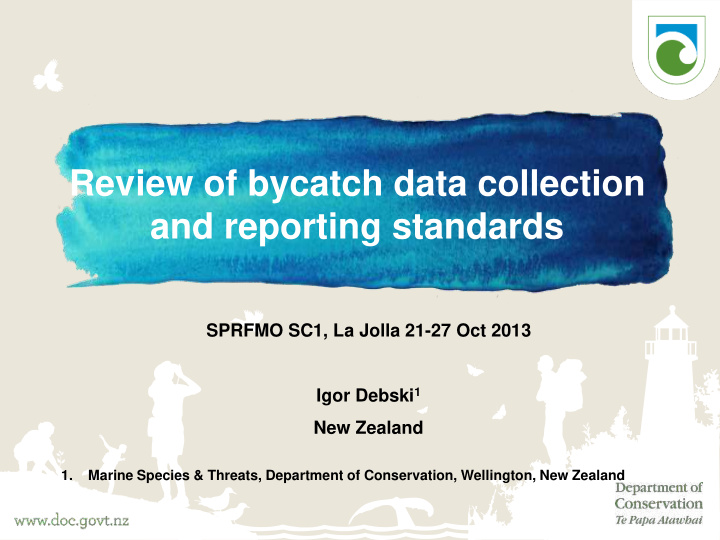



Review of bycatch data collection and reporting standards SPRFMO SC1, La Jolla 21-27 Oct 2013 Igor Debski 1 New Zealand 1. Marine Species & Threats, Department of Conservation, Wellington, New Zealand
Roadmap for the Scientific Committee h) To review the standards for data collection and reporting, and for observer coverage to ensure a full understanding of the nature and extent of bycatch interactions across all fisheries.
Endangered, Threatened & Protected (ETP) species A working definition in the SPRFMO context: • seabirds • marine mammals • reptiles • some fish species, primarily the elasmobranch species listed by CMS and CITES (e.g. Cetorhinus maximus , Carcharodon carcharias, Manta birostris, Rhincodon typus) Note: this definition excludes endangered, threatened or protected invertebrate species.
Importance Collecting robust ETP bycatch and associated data are important in order to: • characterise and quantify bycatch within a fishery; • understand the nature of bycatch and the importance of various factors in contributing to the observed level of bycatch, enabling the identification of specific solutions for the particular fishery; and • assess and monitor the effectiveness of bycatch mitigation measures in reducing mortality.
ETP data harmonisation Many ETP species are highly migratory and can be subject to bycatch across multiple EEZs and RFMO areas, as well as other human threats Harmonisation of data collection and reporting allows cumulative risk assessment (e.g. for seabirds, process being led by ACAP).
Review – Observer data Current standards described in CMM 1.03 Annex 8 were compared against: • FAO technical guidelines • other international recommendations on minimum standards (e.g. Dietrich et al. 2007; Wolfaardt 2011 – SC-01-INF-11) and • New Zealand domestic ETP bycatch data collection experience Areas where additional information should be collected are highlighted
Observer data types for ETP • ETP captures o ETP identification • use of mitigation • environmental data • fishing operational data
Data on ETP captures Section G • in 1.b) by including numbers caught for each species (currently, only a count of the total number caught per tow or set is required) • by identifying the type of interaction e.g. hooking/entanglement • record sex of each individual for taxa where this is feasible from external observation, e.g. pinnipeds, small cetaceans, any ETP sharks • record details of any bands or tags • describe any circumstances directly related to the bycatch event (e.g. tori line tangle, offal discharge)
ETP species identification Section G • in 1. d) by developing better protocols for identification and collection of specimens to allow confirmation of identification. Potential options include: o return of carcases for necropsy and expert examination; o implementation of photographic protocols for expert confirmation; o collection of tissue samples for genetic determination (e.g. seabird feathers); o multilingual training processes and identification manual for observers. For seabirds, protocols are described for much of this data collection in the draft seabird identification guide being developed by ACAP SC-01-INF-12-rev1.
Use of mitigation Sections B and D • record any offal and discards management (e.g. were there any discards during setting or hauling, or during towing for trawl fisheries); • record detailed information on bycatch mitigation measures employed. Amend Section B 2. q) and Section D 2.n) to require detail on: o whether a tori line was used (yes/no); o the number of tori lines used; o the aerial coverage of the tori line; Section D only o if night-setting occurred; o weight added to branchline; o weight added to mainline.
Environmental data Sections B, C and D providing detail on physical and environmental factors, including: • sea state; • wind speed and direction; • air and sea surface temperatures.
Fishing operational data Sections B and C • record whether tow/set was observed for ETP captures Section D only • record number of hooks hauled that were observed for ETP captures; • details on weighting regime: o mass of weight; o material of weight (metal/non-metal); o spacing of weights on mainline; o distance from hook of weights on branchline. • sink rate (m/sec), if observer programme capacity allows; • bait type (fish/squid, live/dead, frozen/thawed);
Fishing operational data Section D only (contd) • hook size and shape (J/circle) • use of floats: o yes/no; o size; o spacing on mainline; o length of dropper line.
Data linking Vital that ETP capture data can be linked on a fishing event (set/two) by fishing event basis with mitigation, environmental and fishing operational data in order to fully understand the mechanisms of bycatch.
Reporting Key ETP data fields could form part of standard national reports. Critical elements: • level of observer coverage by fishery (% fishing events observed for ETP captures, including % hooks hauled observed in BLL, as well as number of vessels and days) • Number of ETP captures by species by fishery
Conclusion – observer data This review found the current SPRFMO Data Standards are largely well aligned with international best practice. Some, relatively small, aspects do require further development to ensure full alignment. Such amendments, although small, will be important in enabling the development of a full understanding of the nature and extent of bycatch interactions across all SPRFMO fisheries.
Fishing activity data (Annex 1-7) Which of the ETP related data fields identified for observer data could also be collected by crew? Key fields would be the number and identification, to lowest possible level, of ETP species captured. Provision of identification resources would be required.
Recommendations Recommendation 1: the Science Committee consider and, if appropriate, recommend to the Commission that the data standards described in Annex 8 of CMM 1.03 relevant to the bycatch of ETP species be amended to align these to international best practice, as described in this paper, in order to maximise our understanding of such bycatch. Recommendation 2: the Science Committee consider and, if appropriate, recommend to the Commission that key ETP bycatch statistics be reported as part of standard SPRFMO reporting requirements.
Recommend
More recommend